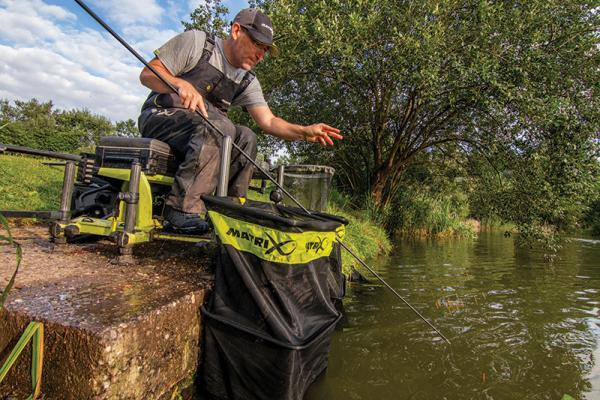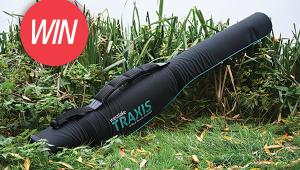The Keepnet Swim

Over the years I’ve definitely learnt the value of fishing right next to my keepnet. It’s helped win me countless matches, scored valuable section points and got me out of jail many a time. It doesn’t matter if you’re on a lake, canal or river, fishing right next to your keepnet should never be overlooked. It’s probably not be a place you’ll fish all day, but it’s still an area you should never disregard. Here’s why…
Canal Lessons
Years of fishing matches on canals first taught me the value of a keepnet swim. Growing up on Midlands canals it was a prime area for small fish, but you’d be surprised what else you’d catch there. At one stage I turned fishing around my nets into a bit of an art form and had specialist rigs just for this line.
Pinning the net to the bank was crucial. It not only stopped passing boats washing it around, but also created a feature and safe haven for fish to investigate and swim under; especially perch and gudgeon.
I even made my own ultra-short whips with rigs already attached; some just a metre long. These days there are so many big fish about it’s much more sensible to use elastic instead of a whip and a 4-6 or 6-8 grade helps set the hook and bully fish quickly to the top.
On some pegs you could catch 100 gudgeon with just a metre of carbon in your hand. Sadly those days have long gone, but perch are still a worthy target. I’d typically still have a ‘normal’ short swim three to five metres out, but the ultra-close keepnet swim is a good place to start or to try whenever a boat passes. Here I would regularly feed a pinch of fine groundbait and trickle a few squatts or pinkies over the top. In winter I used to love flicking pinches of neat joker when it was allowed. Finely minced worm can be better on some canals, with a lively tail segment of worm on the hook.
Sometimes this swim would be almost touching the front of my net. Other days it would be a foot further out, so it all depended on how it plumbed up. If I could find two feet or more I was happy. I’d often plumb tight in to the bank, either side of the net, and have two or three swims on the go, working all three. The best swims had concrete or corrugated ‘tins’ as that generally meant a bit of depth tight in.
I’ve fished countless matches where you could see the bottom close in but still caught fish hiding under the net. Sometimes the fish are so camouflaged that you’d only see them when you hooked them.
River Rewards
I soon carried the same close-in theories to my local River Avon and, if anything, it was even better! I practised the method loads and could regularly catch 5lb plus of perch in the first 90 minutes, which is a great start on any match! Again, beefing up the elastic was essential. Go too soft and the perch will crash around and snag you up too easily. An 8-10 Slik is ideal with maggots and 10-12 or sometimes even heavier if fishing worms on a bigger hook.
On a river I obviously don’t pin the keepnet back as the flow takes care of that. If the river is carrying extra water the back of the keepnet becomes a natural slack for fish to take refuge. Bleak and small silvers will typically sit behind the net, but you could just as easily catch a bonus chub if the river is up and coloured.
When I first discovered the potential of the keepnet swim on rivers (I’m going back 30 years now!) I could keep it going by fishing it in stages. I used to start by just feeding red maggots or fluoro pinkies, just six to 10 at a time. This would catch me a few easy fish. I’d then swap to feeding a bit of cloudy groundbait and get a second burst of action. Once that had been exhausted I’d then introduce chopped worm and that would really boost the peg. This really seemed to prolong the swim’s life and give the highest yield. I definitely don’t approach rivers with as much thought these days, but perhaps I should!
Commercial Gains
Now we are up to the present day and a keepnet swim can be just as vital to my game plans on commercials. On lots of venues you can catch right in between your nets. They are often good-sized fish as well; crafty and opportunist feeders who have got used to a free meal from pole pots and feeders being spilled.
I often take advantage of this and will just drip feed the area with a pinch of bait. It could be corn, meat or a pinch of pellets. Sometimes feeding larger dollops will spook the fish; especially early on in the session. However, with an hour or less to go it’s worth doing the opposite and ‘filling it in’ to mimic packing away.
The bottom here is normally really clean from the repeated dragging out of keepnets. Plus, people throw their leftover bait in on this line all the time, whether they are supposed to or not. Angling textbooks normally say the fish come down the edge late on because people throw their leftover bait down the margins after packing up. However, I think more bait gets hoofed in just a metre or so in front of where they’ve sat, so bear that in mind!
I fish several venues that have platforms that jut out into the water a metre or so. Summer or winter, these platforms are natural features, sanctuary and bait larders. I know a few other places that are mega shallow close in, yet the fish will still pop up in between your nets – and big ones too! So, plumb this area up as a throwaway swim and throw a pinch of bait down there while you fish elsewhere. A minute spent trying it occasionally could easily produce a match-winning fish out of the blue.
On the canal I would just have a long elasticated No1 section in my hand. On a commercial, however, you are much more likely to catch an angry carp, so gear up accordingly! A short kit will be fine for F1s, but on a proper carp lake I prefer a standard-length top two kit. This might mean fishing with half or more of the top kit jutting behind you or pointing down a bit. It might look awkward, but the extra elastic is vital.
There are two trains of thought with this swim. One is to fish normal to light elastic and let the fish kite out gracefully once hooked. The other is to step things up, hit the fish quickly and stun it into the net before it can bolt out to the middle of the lake. On most occasions I prefer this latter no-nonsense style!
I’d probably use a minimum 14-16 Slik, 0.18mm line and a decent size 14 or 12 ‘gaff’ with a big hook bait. Something like a big 8mm Sonubaits Pro Expander, a lump of paste or an 8mm to 10mm cube of meat. Avoid worms as those crafty little perch I’m targeting on canals and rivers are rarely what I’m after on a commercial!
7 Net Tips
1. Get your keepnets in the swim as soon as you can, so fish in the area can get acquainted with them.
2. Always place your nets in quietly. Never throw them in!
3. Pin the net to the bank if you can. I use old pole elastic and a tent peg to secure it in position. Always make sure the entire net is submerged with plenty of room for the fish to swim about.
4. A black ‘carp sack’ type net with a tight mesh weave is best. This ensures the fish on the outside cannot see the fish on the inside.
5. Keep your keepnets relatively high to prevent fish jumping out. Carp and chub are particularly prone to escape attempts.
6. By placing your keepnet high it can double up as a rest when you are fishing close in, or even a rod rest when you are fishing further out.
7. This should apply whether you fish close in or not, but check your nets for holes on a regular basis!
- Log in or register to post comments













